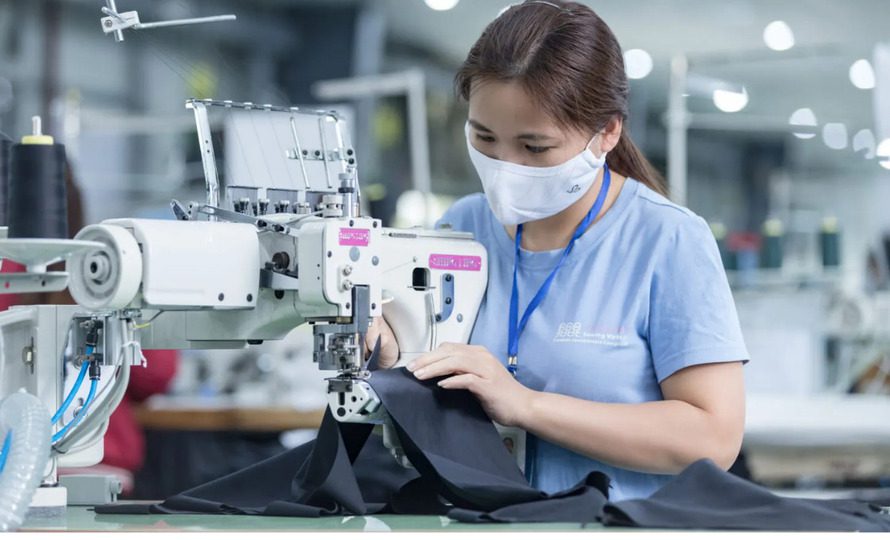Locating a manufacturing partner for your apparel line counts as a significant milestone. The Asian continent stands as a principal sartorial industry powerhouse. The region boasts an immense amount of expertise and it is really cost-effective.
This article presents a clear, 5-step process. It will guide you to a partner making high-quality clothes. After all, you will avoid money loss and make a solid base for your brand with their help.
Here are the topics you will address:
- Check Portfolio, Skills and Certifications
- The Key Sample Review Process
- Understand Communication and Culture
- Check Technical Skills and Equipment
- Verify Ethics and Business Trust
Step 1: Check Portfolio, Skills, and Certifications
The first step is your research. You should check a factory’s background before you even think about emailing them. This is a big time-saver; you will eliminate the weak options in advance.
Examining Previous Projects and Clients
An online portfolio is a manufacturer’s first thing to check. Look carefully at those pictures and don’t stop at the gallery only. Look at the small features of the clothing they present. Can they create intricate details? Can they work with challenging fabrics like silk or high-tech materials?
Then, you can go through a list of their long-term clients. Temporary clients are a poor sign. A factory that works with its clients for a long time is serious, as it has earned their trust and has proven its reliability. Consequently, this is evidence that the factory can wholesale high-quality goods.
Aligning Their Skills with Your Requirements
You should be aware that not all factories are the same. A factory that can create basics may not be able to create specific designs. Thus, you need to find a high-quality Clothing Manufacturer focusing primarily on your product line.
Automatic matching for them could be with their machinery, workforce, and material suppliers. It remains true for the production of denim, active wear, or evening gowns. For instance, the details of the luxury clothing manufacturing process are that it requires careful attention and the right fabrics that only a highly skilled factory can offer.
Verifying the Critical Industry Certifications
Certifications are the visible evidence of a factory’s dedication to quality and ethics. They are not just random logos that a factory can put on a website. These show the factory has passed the inspection by an independent organization. The following key certifications are important to check:
- ISO 9001: This certification means the factory has a solid quality management system that works. It ensures the organizational culture of making quality products is embraced.
- WRAP (Worldwide Responsible Accredited Production): This certification focuses on the factory’s treatment of workers. It ensures they receive fair wages, work in a safe environment with legal hours.
- GOTS (Global Organic Textile Standard): If your brand is into organic textiles, it is of utmost importance. It means the value chain from the farm to the factory is indeed organic.
- OEKO-TEX: This certification confirms that the fabric is safe to be used and has been tested for the presence of harmful chemicals. It is a promise to the consumers that their health will not be compromised.
Step 2: The Key Sample Review Process
Having done the basic research, it is time to view the actual proof. The sampling stage is where you see firsthand the factory’s skills. An excellent sample is the best evidence of the production run’s success.
From Tech Pack to First Sample
A tech pack is detailed instruction for making a design. It includes all measurements, types of materials, and specifications for sewing. A well-written tech pack is the only way to receive a correctly made first sample.
Communicate with the manufacturer about the timelines and the cost of samples. Be prepared to pay for the service as it tends to cover the time and effort for the work to create a single customized piece.
A Checklist for Sample Quality Control
Upon sample arrival, check it properly. Don’t only look; also touch and measure it. Rank it virtually with a checklist that provides an organized way to view the quality and a way of missing items.
- Stitching: Are the seams straight and even? Are there any loose threads? Pull-over seams gently to check if they are strong.
- Fabric: Is the fabric in terms of touch and vision what you ordered? Look at the weight and how it is hanging.
- Fit & Size: Use the measuring tape to compare the sample to your tech pack. Did the design fit as you planned?
- Finishing: See whether the details are okay. Are the buttons, securely sewn on, zippers working smoothly, labels are straightly placed and neat?
- General Build: Is the garment solid to touch? Will it retain its form? It should feel complete as a product rather than a draft.
Amending and Feedbacks
It’s a rare case that the first sample is perfect without any defect. The way a manufacturer reacts to your criticism is their potential deep quality test. Write clear notes and include photos that are illustrative of the required changes.
A manufacturer who is a good partner will comprehend your requests and create an improved sample. Speed, as well as accuracy, in making those changes point to the way you will collaborate during full production. This task is a barometer of their communication and problem-solving skills, which are crucial for smooth alliance.
Step 3: Understand Communication and Culture
The strong part of locating a quality partner goes beyond the technical aspect. Crystal-clear communication is the foundation of a constructive relationship. Miscommunication is a channel to errors that can lead to huge delays and needless expenditures.
Proficiency in English and Response Times
Effective communication is beyond just speaking in English but also being precise, detailed, and quick in response. Sales personnel that don’t reply emails within a day are a big red flag.
Consider a situation when you are in urgent production trouble. In this case, you need a partner who responds instantly and shares your worries. A slow response rate in easy scoping, which typically is the main restriction during hard projects, hints to a potential slow process.
Explaining Through Symbols and Clear Instruction
Language obstacles can be troubles. The best way to conquer them is by pictures and instructing clearly. This is a secret from our long-standing experience in factory work across Asia.
Instead of stating things in a long text, add images. For example, instead of saying, “move the button up slightly,” just take a photo of the garment with an arrow pointing to it. Use short videos to clarify complex issues. This simple method prevents misunderstanding and ensures that everyone is on the same page. It makes your instructions impossible to misunderstand.
Step 4: Check Technical Skills and Production Equipment
Now it’s time to take a look at what is going on behind the scenes. You should assess the capabilities of the factory to see whether they are really prepared to produce high-quality clothing. Asking relevant questions reflects you as a serious partner who has a good grasp of the process.
Inquiring About Machines and Competencies
The first point of discussion is the factory’s equipment. Are they equipped with the machinery that you need? Suppose that you are manufacturing activewear, in this case, the flat-lock machines recognize the need for strong, comfortable seams.
Attend to the skills of their personnel. Do they have a crew with experience in working with delicate materials or intricate sewing techniques? A factory that invests in cutting-edge equipment and expert labor is certainly a high-quality clothing manufacturer.
Grasping Their Quality Control Procedure
The factory Quality Control (QC) process guarantees the delivery of a good end product. A robust QC system has to be multidimensional. Ask them to detail it out for you.
- Incoming Material Check: They should check all fabrics and trims when they arrive. This stops problems before sewing even begins.
- In-Line Check: Workers should check garments at different points on the assembly line. This catches mistakes early, when they are easy to fix.
- Final Check: Before packing, a QC team should inspect a portion of the finished items. This final check ensures the entire order meets your standards.
A factory that has a robust quality control program that includes multiple check phases is a vendor you can trust.
Step 5: Verify Ethics and Business Trust
The last step is about trust and safety. Before you send a big order, you must validate that the factory is a genuine and responsible entity. This preserves both the brand’s standing and the money.
Conducting Factory Audits
The most effective way to validate the factory is to witness it. Visiting the factory will provide you with better proof. However, if you are not able to, you may request a live video tour. They should show you the factory floor, the cutting room, and packing areas.
Such a virtual audit will give you an insight into the working conditions and the general conditions of the factory’s space. A factory that is clean, organized, and happy to show you around is a good sign.
Checking for Social and Environmental Rules
Today’s customers are mindful of where their clothes come from and want them to be made ethically. Associating with responsible manufacturers is a people and profit thing. This takes us back to the Step 1 certifications.
Make sure the factory adheres to fair labor laws and has a safe working environment. Telling the truth about ethical practices is one of the things the best clothing manufacturers do. Ask them to share their social compliance policies.
Reviewing MOQ, Pricing, and Payment Terms
Lastly, confirm all the business terms. MOQ stands for Minimum Order Quantity, the smallest order they will accept. Make sure their MOQ fits your business needs.
Get a detailed price quote that will make you know precisely what you are paying for. Go over the payment terms. A traditional and fair arrangement is an upfront deposit (like 30-50%) in the beginning, and the final payout is due after the goods are approved.
Conclusion: Your Blueprint for a Successful Partnership
It’s a painstaking exercise to discover the right manufacturing partner in Asia. But once you implement the five steps, the road to your success becomes clear. It is hard work, but the results of the effort sit beautifully as an investment in the future of your brand.
A high-quality clothing manufacturer is more than a supplier; they are a partner in your growth which you badly need. Brands that are fully prepared to initiate their partnership with a vetted partner can explore their available options at https://clothingmanufacturerltd.com
Frequently Asked Questions (FAQ)
What are the main red flags when it comes to searching for a manufacturer in Asia?
Such red flags include vague or slow communication, the company’s unwillingness to produce a sample, lack of transparency about their factory or processes, and pressure for full payment upfront. In addition, a portfolio that appears haphazardly or uses stock images can be a warning sign.
How much should I expect to pay for samples?
Prices for samples can be quite variable, but you should generally expect to pay about 2 to 4 times the final cost of the production of the units. This is because of skimpy production overheads, pattern making, and labor costs. Some manufacturers may be willing to deduct the cost of the samples if you place an order for a large quantity.
What is the expected MOQ for a startup?
In Asia, minimum order quantities can be anywhere from 50 to 100 pieces each for colors with small, flexible factories to over 1000 for larger operations. Startups should look for small factories with 100-300 products as a starting point for the perfect blend of inventory risk and price efficiency.
Is it necessary to visit the factory in person?
While it is the gold standard, it is not always possible for startups. A well-structured virtual audit via video call, combined with thorough sample evaluation and reference checks, can be a very effective alternative. Ask for a live tour of the production floor, cutting room, and QC station.
What’s the difference between a CMT and FPP manufacturer?
CMT (Cut, Make, Trim) means you provide the fabric and designs, and the factory handles the assembly. FPP (Full Package Production) is a more complete service where the manufacturer manages everything from sourcing materials to production and packaging, based on your tech pack. FPP is often preferred by new brands for its simplicity.
Read More From Techbullion



































